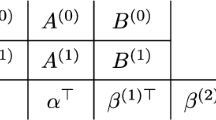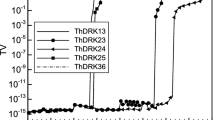Abstract
When one solves differential equations, modeling physical phenomena, it is of great importance to take physical constraints into account. More precisely, numerical schemes have to be designed such that discrete solutions satisfy the same constraints as exact solutions. Nonstandard finite differences (NSFDs) schemes can improve the accuracy and reduce computational costs of traditional finite difference schemes. In addition NSFDs produce numerical solutions which also exhibit essential properties of solution. In this paper, a class of nonstandard 2-stage Runge–Kutta methods of order two (we call it nonstandard RK2) is considered. The preservation of some qualitative properties by this class of methods are discussed. In order to illustrate our results, we provide some numerical examples.
Similar content being viewed by others
References
E. Hairer and G. Wanner, Solving Ordinary Differential Equation II: Stiff and Differential-Algebraic Problems (Springer, Berlin, 1996).
R. E. Mickens, Nonstandard Finite Difference Models of Differential Equations (World Scientific, Singapore, 1994).
R. Anguelov and J. M.-S. Lubuma, and F. Minani, “Total variation diminishing nonstandard finite difference schemes for conservation laws,” J. Math. Comput. Model. 51, 160–166 (2010).
R. Anguelov and J. M.-S. Lubuma, “Contributions to the mathematics of the nonstandard finite difference method and applications,” Numer. Methods Partial Differ. Equations 17, 518–543 (2001).
C.-W. Shu, “Total-variation-diminishing time discretizations,” SIAM J. Sci. Stat. Comput. 9, 1073–1084 (1988).
A. Gerisch and R. Weiner, “On the positivity of low order explicit Runge–Kutta schemes applied in splitting methods,” Comput. Math. Appl. 45, 53–67 (2003).
W. Hundsdorfer and J. G. Verwer, “Numerical solution of time-dependent advection-diffusion-reaction equations,” in Springer Series in Computational Mathematics, Vol. 33 (Springer, Berlin, 2003); SIAM J. Numer. Anal. 18, 21–36 (1981).
W. Hundsdorfer, S. J. Ruuth, and R. J. Spiteri, “Monotonicity-preserving linear multistep methods,” SIAM J. Numer. Anal. 41, 605–623 (2003).
N. N. Pham Thi, W. Hundsdorfer, and B. P. Sommeijer, “Positivity for explicit two-step methods in linear multistep and one-leg form,” BIT Numer. Math. 46, 875–882 (2006).
C.-W. Shu, “Total-variation-diminishing time discretizations,” SIAM J. Sci. Statist. Comput. 9, 1073–1084 (1988).
C.-W. Shu and S. Osher, “Efficient implementation of essentially nonoscillatory shock-capturing schemes,” J. Comput. Phys. 77, 439–471 (1988).
Z. Horvath, “Positivity of Runge–Kutta and diagonally split Runge–Kutta methods,” Appl. Numer. Math. 28, 309–326 (1998).
A. M. Stuart and A. R. Humphries, Dynamical Systems and Numerical Analysis (Cambridge Univ. Press, Cambridge, 1998).
J. C. Butcher, The Numerical Analysis of Ordinary Differential Equations: Runge–Kutta and General Linear Methods (Wiley, New York, 1987).
B. Koren, “A robust upwind discretization method for advection, diffusion and source terms,” in Numerical Methods for Advection-Diffusion Problems, Ed. by C. B. Vreugdenhil and B. Koren, Notes on Numerical Fluid Mechanics (Vieweg, Braunschweig, 1993), Vol. 45, pp. 117–138.
Author information
Authors and Affiliations
Corresponding author
Additional information
The article is published in the original.
Rights and permissions
About this article
Cite this article
Khalsaraei, M.M., Khodadosti, F. Qualitatively stability of nonstandard 2-stage explicit Runge–Kutta methods of order two. Comput. Math. and Math. Phys. 56, 235–242 (2016). https://doi.org/10.1134/S0965542516020123
Received:
Accepted:
Published:
Issue Date:
DOI: https://doi.org/10.1134/S0965542516020123




